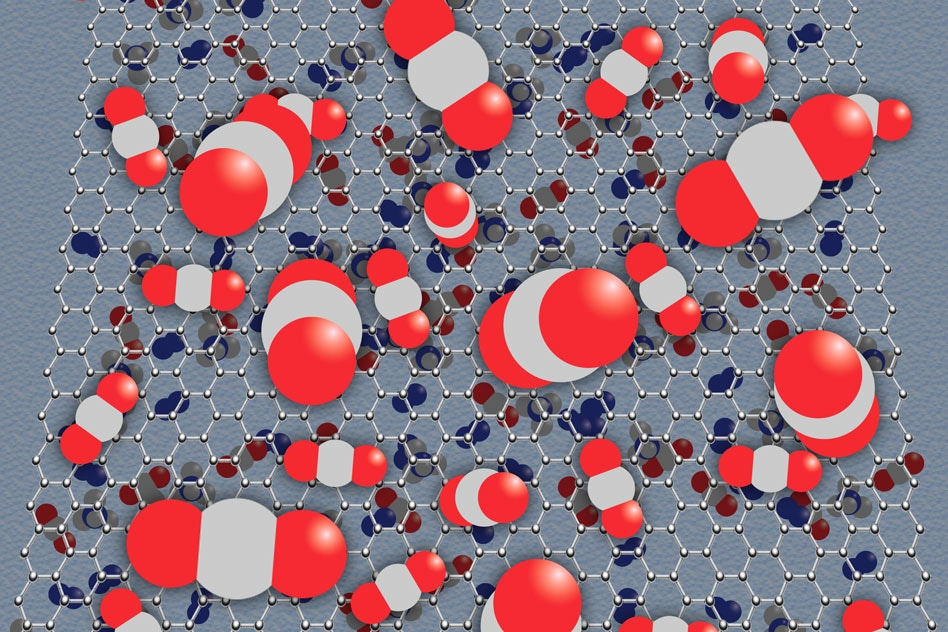Apr 10 2019
Natural gas and biogas have become progressively popular energy sources across the globe in recent years. This is because of their cleaner and more efficient combustion process compared to coal and oil. However, the presence of pollutants such as carbon dioxide (CO2) within the gas means it must first be decontaminated before it can be combusted as fuel.
 MIT researchers have developed a new polymer membrane that can dramatically improve the efficiency of natural gas purification, while reducing its environmental impact. (Image credit: Chelsea Turner, MIT)
MIT researchers have developed a new polymer membrane that can dramatically improve the efficiency of natural gas purification, while reducing its environmental impact. (Image credit: Chelsea Turner, MIT)
Traditional processes to decontaminate natural gas usually involve the use of poisonous solvents and are very energy-intensive.
Consequently, scientists have been exploring the use of membranes as a way to eliminate impurities from natural gas in a more economical and environmentally friendly manner, but identifying a polymer material that can isolate gases quickly and efficiently has thus far proven to be difficult.
In a paper published recently in the journal Advanced Materials, scientists at MIT describe a new type of polymer membrane that can intensely enhance the efficiency of natural gas purification while lowering its environmental impact.
The membrane, which has been engineered by an interdisciplinary research team at MIT, can process natural gas much more rapidly than conventional materials, according to lead author Yuan He, a graduate student in the Department of Chemistry at MIT.
“Our design can process a lot more natural gas — removing a lot more carbon dioxide — in a shorter amount of time,” he says.
Current membranes are usually produced using linear strands of polymer, says Zachary Smith, the Joseph R. Mares Career Development Professor of Chemical Engineering at MIT, who led this work.
“These are long-chain polymers, which look like cooked spaghetti noodles at a molecular level,” he says. “You can make these cooked spaghetti noodles more rigid, and in so doing you create spaces between the noodles that change the packing structure and the spacing through which molecules can permeate.”
However, such materials are not adequately porous to permit CO2 molecules to permeate through them at a rapid enough rate to compete with current purification processes.
Rather than using long chains of polymers, the scientists have developed membranes in which the strands resemble hairbrushes, with minute bristles on each strand. These bristles enable the polymers to isolate gases a lot more effectively.
We have a new design strategy, where we can tune the bristles on the hairbrush, which allows us to precisely and systematically tune the material. In doing so, we can create precise subnanometer spacings, and enable the types of interactions that we need, to create selective and highly permeable membranes.
Zachary Smith, study Lead and the Joseph R. Mares Career Development Professor, Chemical Engineering, MIT.
In experiments, the membrane was able to endure unparalleled CO2 feed pressures of up to 51 bar without suffering plasticization, the scientists state. This compares to about 34 bar for the best-performing materials. The membrane is also 2,000–7,000 times more permeable than conventional membranes, according to the team.
Since the side-chains, or “bristles,” can be predesigned prior to being polymerized, it is a lot easier to integrate a variety of functions into the polymer, according to Francesco Benedetti, a visiting graduate student within Smith’s research lab in the Department of Chemical Engineering at MIT.
The study also included Timothy Swager, the John D. MacArthur Professor of Chemistry, and Troy Van Voorhis, the Haslam and Dewey Professor of Chemistry, MIT graduate students Hong-Zhou Ye and Sharon Lin, M. Grazia DeAngelis at the University of Bologna, and Chao Liu and Yanchuan Zhao at the Chinese Academy of Sciences.
“The performance of the material can be tuned by making very subtle changes in the side-chains, or brushes, that we predesign,” Benedetti says. “That’s very important, because it means we can target very different applications, just by making very subtle changes.”
Furthermore, the scientists have learned that their hairbrush polymers are better able to endure conditions that would cause other membranes to fail.
In current membranes, the long-chain polymer strands overlap each other, sticking together to produce solid-state films. But after a while the polymer strands slide over each other, causing a chemical and physical instability.
In the latest membrane design, in contrast, the polymer bristles are all linked together by a long-chain strand, which serves as a backbone. Consequently, the individual bristles are incapable of moving, forming a more stable membrane material.
This stability offers the material extraordinary resistance to a process called plasticization, wherein polymers swell when exposed to aggressive feedstocks such as CO2, Smith says.
“We’ve seen stability that we’ve never seen before in traditional polymers,” he says.
Using polymer membranes for gas separation provides minimal environmental impact, high energy efficiency, and standard and continuous operation, but existing commercial materials possess low permeance and moderate selectivity, rendering them less competitive than other more energy-intensive processes, says Yan Xia, an assistant professor of chemistry at Stanford University, who was not involved in the study.
“The membranes from these polymers exhibit very high permeance for several industrially important gases,” Xia says. “Further, these polymers exhibit little undesired plasticization as the gas pressure is increased, despite their relatively flexible backbone, making them desired materials for carbon dioxide-related separations.”
The team is presently planning to perform a systematic research of the chemistry and structure of the brushes, to examine how this impacts their performance, he says.
“We are looking for the most effective chemistry and structure for helping the separation process.”
The researchers also want to explore the use of their membrane designs in other applications, such as carbon capture and storage, and even in isolating liquids.